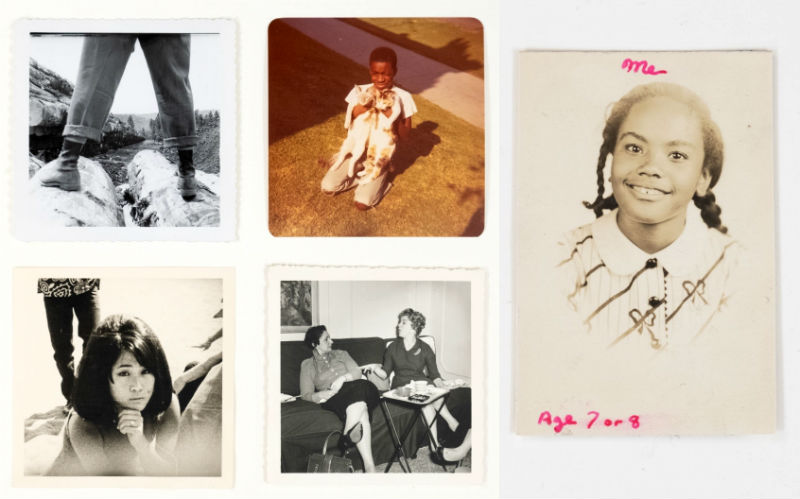Ordinary People: UMMA's "Take Your Pick: Collecting Found Photographs" asks us to help curate the everyday

This review was originally published October 8, 2019. We're rerunning it because UMMA just launched a virtual version of this exhibit featuring 250 photographs that visitors selected to enter the museum's permanent collection. View the online exhibit and learn about the history of snap photography here.
In the University of Michigan Museum of Art’s latest photographic exhibit, Take Your Pick, viewers are asked to participate in the selection of images to be added to the permanent collection. UMMA asks us to head to the gallery and look at the 1,000 amateur photographs collected by Peter J. Cohen and decide on our 20 personal favorites. Ballots are available at the entrance of the gallery, with 20 slots to vote for your favorite photographs. On the exhibit's webpage, potential visitors are asked to “Come help build [UMMA's] collection of ‘ordinary’ American 20th-century photographs.” With an emphasis on the word ordinary, the curatorial team is asking viewers to consider how “ordinary” photographs of the 20th century may be reconsidered as objects worthy of preservation and study.
The photographs on display are part of a larger collection of 60,000 snapshots collected by Peter J. Cohen. Cohen acquired his collection by searching through flea markets and buying online. The majority of the images portray candid American life, distilled imagery of private family life: birthday parties, family vacations, school portraits.
I visited the exhibition the first business day after the show opened and was fortunate enough to obtain a statistic from Assistant Curator of Photography Jennifer M. Friess on the success of the audience-based voting. After only two full days of being open to the public, the photographs in Take Your Pick received 8,355 votes between 457 ballots. In this time-frame, all but 50 images received at least one vote.
So how does the voting work? Simply enter the gallery and pick up a ballot and pencil. After voting, visitors are encouraged to share the reasons behind their choices and why these reasons matter for the future of contemporary collecting. What do these photographs represent about American life and values that make them significant?
In the center of the gallery, a large table holds printed cards, available for sharing individual responses to the photographs. Two types of cards are available, complete with prompts: “Imagine and share a story about photograph #" and “I think the Museum should choose photograph #____ because:” Written responses can be posted on a large bulletin board and votes are collected in a bin near the ArtGym gallery entrance. After voting, sticker enthusiasts like myself may also collect a sticker that says, “I VOTED AT UMMA.”

In the exhibition wall text, Friess asks the audience two pertinent questions to consider while voting: “Who and what should be represented in the Museum’s collection, and how should we decide? What will future audiences think is important for the Museum to display and study from twentieth-century American life?” While contemplating these questions, I walked around quite a bit, revisiting each image more than once, until my card was filled.
The content of the images was immediately familiar and unknowable, strangers enacting similar cultural rituals, echoing the family albums I grew up seeing. In the gallery wall text, Friess states: “In our current digital age, these pictures have particular resonance as visual artifacts of the twentieth century, and of a technology -- the analog camera -- which is now largely defunct.” Though the technology used to capture quotidian life has dramatically shifted, becoming ubiquitous and commonplace, we continue to document lives lived through digital photographic images.
These analog photographs feature many scenes familiar in our digital landscape, offering us a collection of photographs that illustrate there's a long history behind the “selfie” going beyond the Age of Instagram. Friess also points out that art museums have consistently overlooked and undervalued the snapshot and other forms of colloquial photography “despite its large role in the history of art making.” Photography often played a crucial, yet unacknowledged role in the production of paintings as a referent for form, composition, and, later, color. UMMA wants to change this with Take Your Pick, not only giving the snapshot a platform but asking for public participation in deciding its future.
Deciding on only 20 of 1,000 images is a difficult task, each image seemingly worthy of attention in the gallery space. Many images struck me as “important” artifacts of American life. Among these, an image of a man taking a “selfie” in the mirror with his analog camera, and a photograph of two young children in a playpen, one holding a toy camera while the photograph was taken. These examples suggest an evolution of the camera from a mechanized process requiring special expertise to the more accessible film cameras in the latter half of the 20th century, to the current ubiquitous phone camera.
Top-voted rankings are tallied every Tuesday and can be found online on the exhibition page.
While voting will remain open through January 12, the final picks will be on view through February 23, 2020.
Elizabeth Smith is an AADL staff member and is interested in art history and visual culture.
View the online version of the exhibit and learn about the history of snap photography here.


































